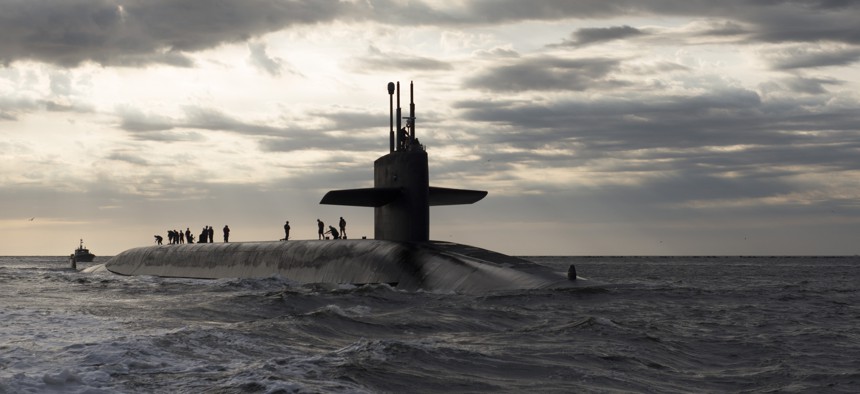
The U.S. Navy's ballistic missile submarine Rhode Island, seen here in a 2013 photo, is among the nuclear-armed platforms covered by the New START Treaty with Russia. U.S. Navy / Mass Communication Specialist 1st Class James Kimber
At Trump-Putin Meeting, Start with New START
If the treaty is allowed to disappear, so will the Pentagon’s best tools for divining facts about the Russian nuclear arsenal.
President Trump apparently has "no specific agenda" for his first in-person meeting with Russian President Vladimir Putin, slated to occur this week on the sidelines of the G-20 Summit meeting in Hamburg, Germany. So we’d like to suggest one: stabilizing the increasingly troubled relationship between the world’s two largest nuclear powers, beginning by extending the landmark New Strategic Arms Reduction Treaty, or New START.
Tensions between the U.S. and Russia have worsened over the past few years, thanks to Moscow’s election interference, annexation of Crimea, continued destabilization of Ukraine, and support for the Assad regime in Syria. Nevertheless, the two countries continue to share common interests. In particular, as the possessors of over 90 percent of the roughly 15,000 nuclear weapons on the planet, they have a special responsibility to avoid direct conflict and reduce nuclear risks. The downward spiral in relations makes these objectives all the more urgent.
One of the few remaining bright spots in the U.S.-Russia relationship is New START. Signed in 2010, the treaty requires each side to reduce its deployed strategic nuclear forces to no more than 1,550 warheads and 700 delivery systems by 2018. It also includes a comprehensive suite of monitoring and verification provisions to help ensure compliance with these limits. So far, both sides have abided by its terms, a good measure of how much they value its contributions to bilateral stability, predictability, and transparency.
The agreement, which is slated to expire in 2021, can be extended by up to five years if both Moscow and Washington agree. But if it is allowed to lapse, there will be no limits on Russia’s strategic nuclear forces; moreover, the United States would have fewer tools with which to verify the size and composition of the Russian nuclear stockpile. This could lead military planners to make worst-case assessments that might help justify a costly and potentially unnecessary surge in nuclear and conventional weapons procurements.
For these reasons and more, the U.S. military and U.S. allies continue to strongly support the agreement. For example, Gen. John Hyten, who leads U.S. Strategic Command, told Congress in March that he is a “big supporter” of New START. Hyten added that “bilateral, verifiable arms control agreements are essential to our ability to provide an effective deterrent.” It seems likely the Pentagon would welcome an extension.
Likewise, in a statement at an international nuclear disarmament conference last summer, a group of U.S. European allies, including Germany and Poland, praised New START and even called on the United States and Russia to begin negotiations to further reduce their nuclear forces.
The deterioration of the U.S.-Russian relationship has only increased the value of New START. By verifiably capping U.S. and Russian deployed nuclear forces, the treaty bounds the current tensions between the two countries. This is especially important because other key pillars of the U.S.-Russia arms control architecture, like the bilateral relationship more broadly, are under siege.
Most problematically, the United States has accused Russia of testing and deploying a ground-launched cruise missile in violation of the 1987 Intermediate-Range Nuclear Forces, or INF, Treaty. Moscow denies it is violating the agreement, and in return has accused Washington of breaching the accord. In addition, U.S. and NATO officials have expressed concern that Russia is developing new nuclear weapons and lowering the threshold for when it might consider using them.
By extending New START, Trump and Putin could add stability and predictability at a time when both are in short supply in the relationship.
Despite these obvious benefits, critics of the treaty in the United States are already taking steps to block an extension. The version of the fiscal year 2018 defense authorization bill passed by the House Armed Services Committee last week would prohibit extending New START until Russia returns to compliance with the INF treaty.
This is senseless and counterproductive. By “punishing” Russia’s INF violation in this way, the United States would simply free Russia to expand the number of strategic nuclear weapons pointed at the United States after New START expires in 2021.
Unfortunately, President Trump has called New START a one-sided deal that favors Russia. He also reportedly responded negatively to Putin’s suggestion to extend that treaty in a January phone call. In addition, Trump has pledged to “strengthen and expand” already formidable U.S. nuclear capabilities.
These comments suggest the president is ill-informed about the treaty, which places equal limits on both sides. They also put him at odds with his Secretaries of Defense and State, both of whom support the treaty; and they reflect a lack of understanding about the unique dangers posed by nuclear weapons.
Extending New START would be an easy win for the President. It could help create a positive atmosphere for improving the U.S.-Russia relationship without making an unwise or impractical concession to Moscow. It would help head off unconstrained nuclear competition, strengthen U.S. and global security, and reassure allies unsettled by both Trump and Putin. Other areas of early action should include agreeing to regularly meet to discuss the full range of issues that affect bilateral nuclear stability, including the particularly thorny work of preserving the INF Treaty.
On the flip side, failing to pursue an extension would be a major missed opportunity. The choice, then, should be a no-brainer.